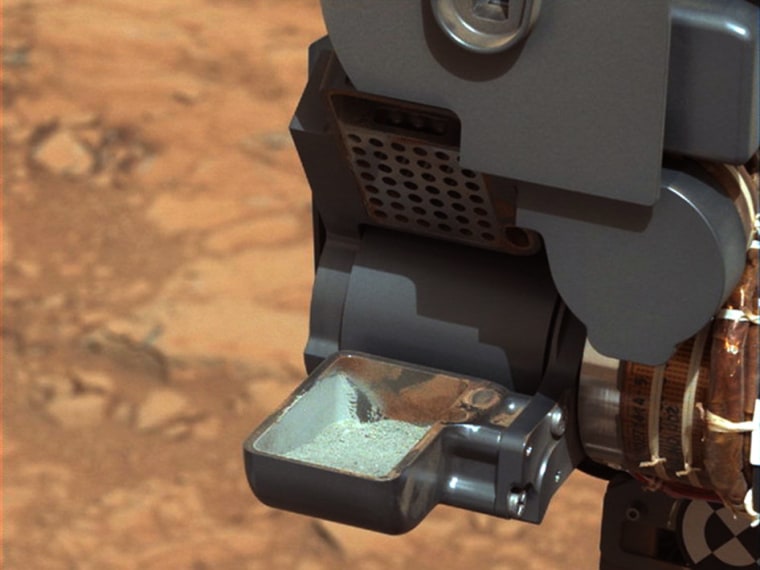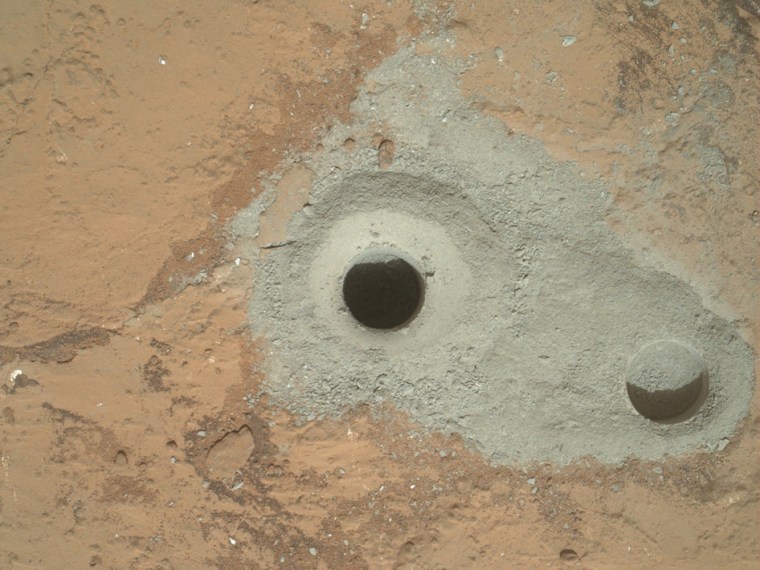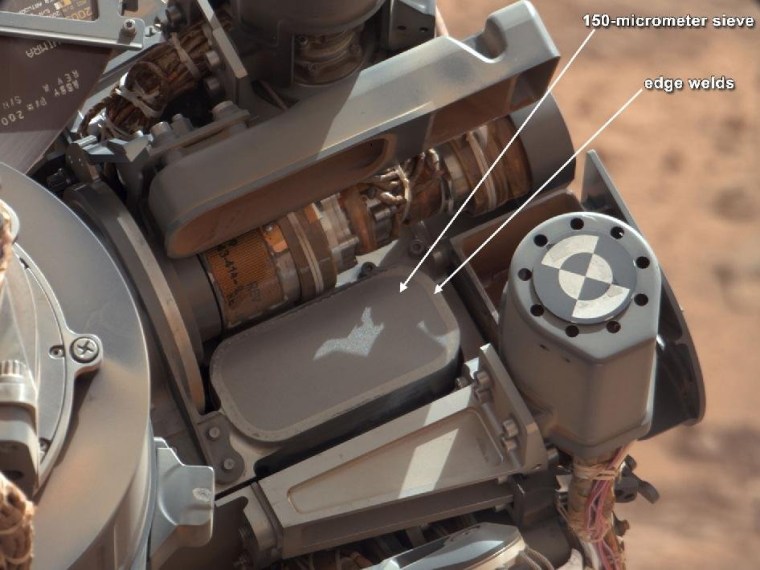
The scientists and engineers behind NASA's Curiosity rover say they're thrilled to see the first tablespoon of rock dust drilled from the interior of a rock on Mars — and they're intrigued by the fact that it's gray, not red.
"We're seeing a new coloration for Mars here, and it's exciting for us," Joel Hurowitz, sampling system scientist for the Curiosity mission at NASA's Jet Propulsion Laboratory, told reporters during a teleconference on Wednesday.
Things could get more exciting in the next few days, when Curiosity's sampling system drops dollops of the dust into the rover's onboard chemistry labs, known as CheMin (which stands for Chemistry and Mineralogy) and SAM (Sample Analysis at Mars). The main goal of the $2.5 billion mission is to find organic compounds on Mars, and scientists suspect that the gray interior of rocks could preserve those organics better than the red, highly oxidized surface.
"All things being equal, it's better to have a gray color than a red color," said Caltech's John Grotzinger, the mission's project scientist, "just simply because oxidation ... is something that we know destroys organic compounds."
The rover has spent several weeks at a rock formation known as John Klein in preparation for this first drilling operation, six months into what's expected to be a two-year primary mission. Some scientists and engineers have been working for years in anticipation of Wednesday's first sight of ground-up rock in Curiosity's sampling cup.
"For the sampling team, this is the equivalent of the landing team going crazy after the successful touchdown," said JPL's Scott McCloskey, drill systems engineer for the Curiosity mission.
The sample came from a 2.5-inch-deep hole that Curiosity drilled into the Martian bedrock on Feb. 8. One of McCloskey's colleagues at JPL, sample system chief engineer Louise Jandura, noted that this was the first time a rover has drilled samples out of a rock on another planet. Earlier missions have used grinders to scrape off the top layer of a Martian rock, but none has gone down as deeply as Curiosity did.
"In the five-decade history of the Space Age, this is indeed a rare event," she said.
Grotzinger said getting the samples represented the final milestone in the commissioning process for the rover. Last week marked the "passing of the keys to the rover" from the engineering team to the science team, he noted. "It's a real big turning point for us," Grotzinger said.


Going through glitches
It will take a few more days to start analyzing the ground-up rock: Some of the material in the cup is being used to clear out the plumbing in the rover's sample delivery system. Once scientists back on Earth see imagery confirming that everything is working as expected, they'll give the go-ahead for more of the material to be shaken through a sieve and then deposited into CheMin and SAM for analysis.
A software glitch delayed the sampling operation, McCloskey said, but the team found a work-around that allowed the task to continue with no loss of functionality. "It didn't end up being a significant roadblock to getting this done," he said.
Another concern arose when engineers found that the sieve on one of the test items back on Earth started coming loose after about 60 shaking operations, also known as "thwacks." That was a signal to the rover team that there was "reason to be cautious," said JPL's Daniel Limonadi, lead systems engineer for Curiosity's surface sampling and science system.
The team decided to reduce the shaking time from 60 minutes to 20 minutes at a time, which should be long enough for most samples. If it isn't, the rover will just keep shaking the stuff until the job is done, Limonadi said.
What the rocks may reveal
Hurowitz said the evidence so far suggests that Curiosity is looking at a sedimentary rock formation that was "more likely deposited in water." Veins of whitish material appear to consist of calcium sulfate, which could provide additional clues to the formation's aqueous origins. He said about 25 separate analyses have been conducted with Curiosity's Alpha Particle X-ray Spectrometer, more than 100 images have been recorded by the Mars Hand Lens Imager, and the ChemCam instrument has taken 12,000 laser shots at the rock.
The gray color of the rock dust suggests that the interior of Martian rocks may reflect ancient geological processes that are significantly different from the current weathering process on the Red Planet, Hurowitz told NBC News.
"This is something that the science team is really excited about — the fact that the tailings from our drill operation aren't the typical rusty orange red that we associate with just about everything on Mars," he said. "You can probably bet that when things turn orange, it's because there's a rusting process of some kind going on that oxidizes the iron in the rock. So the fact that these rocks aren't that color may be telling us that these rocks didn't go through that process that usually turns things to rust on Mars. It may preserve some indication of what iron was doing in these samples without the effect of some later oxidative process."
Eventually, Curiosity will be commanded to retrace its route and head for a 3-mile-high (5-kilometer-high) mountain known as Aeolis Mons or Mount Sharp. But Grotzinger emphasized that the mission was "discovery-driven" — and that the rover team was in no hurry to have the rover make its mountain trek.
"We're going to take it one step at a time," Grotzinger said.
More about Mars:
- Curiosity finds organics, but are they from Mars?
- Mars rover driving through dried-up stream bed
- Cosmic Log archive on the Curiosity mission
Alan Boyle is NBCNews.com's science editor. Connect with the Cosmic Log community by "liking" the log's Facebook page, following @b0yle on Twitter and adding the Cosmic Log page to your Google+ presence. To keep up with Cosmic Log as well as NBCNews.com's other stories about science and space, sign up for the Tech & Science newsletter, delivered to your email in-box every weekday. You can also check out "The Case for Pluto," my book about the controversial dwarf planet and the search for new worlds.